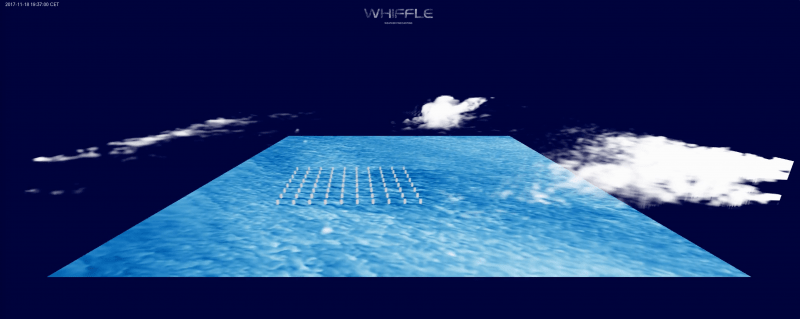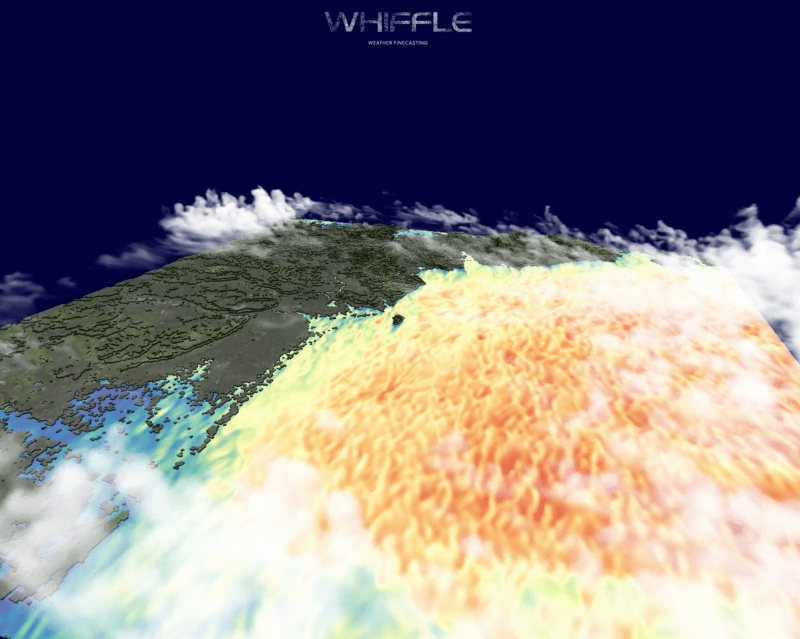The art and science of precisely predicting tomorrow’s local weather patterns almost seems impossible – and just a few years ago it was. That was until Dutch company Whiffle Weather Finecasting managed to develop a new standard of local weather forecasting in 2015.
In just five years, Whiffle’s finecasting data is being used by a substantial number of the Dutch offshore wind farms, but the company is now exploring how it can be deployed to benefit the whole maritime world. Several pilot projects are underway worldwide, one of which took place in the Port of Rotterdam, and results look promising.
Here we interview Founder and Director of Operations Dr Remco Verzijlbergh and he outlines how MARIN and Whiffle are working alongside each other, benefitting from each other’s knowledge and expertise.
Whiffle was founded by Remco and Dr Harmen Jonker, who was at that time the Professor of Atmospheric Physics at Delft University of Technology (TU Delft). Remco was working on a PhD about renewable energy integration. “We realised that detailed local weather forecasting was very valuable for the renewables industry, particularly when integrating the wind and solar farms into the energy system. And given the dramatic growth in wind energy we believed this technology could play a role in the acceleration of the sector. However, we also saw that not much is known about the wind and sun of tomorrow.”
Weather simulation at the HornsRev offshore wind farm in Denmark. Blue shades indicate 10m wind speeds. The turbine wake effects are visible.
“ We have a 3D model of weather parameters like turbulence, cloud formation, wind speed and surface interactions”
Breakthrough due to GPUs
Alongside this, there was a significant technological breakthrough, which was also realised at TU Delft. Whiffle’s unique finecasting technology is based on Large Eddy Simulations, which have been used in academia to examine clouds and turbulence since the 1980s. In 2010, computer scientists at the university were experimenting to see if certain computations could be made by the use of Graphical Processing Units (GPUs). They then looked into the possibilities of ‘translating’ the Eddy model to work on GPUs. “It was amazing – around 100 times faster than normal super computers.”
The company’s atmospheric simulations are designed to run on massively parallel supercomputing platforms and can exploit the spectacular acceleration offered by GPUs. “This breakthrough then made Whiffle’s practical model applications possible in 2015.”
Remco admits that embedding the technology wasn’t entirely without problems at first. “Of course predicting the weather of tomorrow is extremely complex, with all kinds of chaotic phenomena coming into play. We still have a great respect for the accuracy of global weather models. It is not easy to beat state-of-the-art models – the bar is set so high. But at some point we realised our ultra-high resolution approach could improve upon these traditional models and we could beat them!”
Ultra-high resolution at small-scale
The key difference is the ultra-high resolution Whiffle uses for its finecasting, Remco stresses. This facilitates an accurate and natural representation of small-scale processes such as turbulence, surface interactions, cloud formation and precipitation at a certain location and time with unprecedented spatial and temporal detail. The massive computer power offered by the GPUs is crucial for weather predictions over the desired area at a resolution of 100 m or finer. It can actually go to 50 m or even 10 m. For example, it can perfectly capture phenomena that one wind turbine has on another one. Small cumulus clouds of 1 km would be impossible to capture by a traditional model with a resolution of 10 km. “We can represent the laws of physics in a very direct way. We totally mimic nature. Our atmospheric simulations do not reduce reality anywhere near as much as the traditional weather models do.”
Customers include many Dutch wind farms
Whiffle was ready to send data to its first customer in the summer of 2016. Then swiftly afterwards the company started forecasting for the Gemini Wind Park, which is the largest offshore wind farm in the Netherlands. The finecasting system first uses a pre-processing engine to convert large-scale weather data into customised input fields. Forecasting wind energy production depends on the ability to predict wind speeds at the height of the turbine blades. Whiffle’s ultra-high resolution atmospheric model is fully geared towards an accurate modelling of local wind conditions, making it ideal for wind energy forecasts. For example a wind farm operator then knows what it can expect to produce the next day. Most wind farms use the information for trading energy on the dayahead markets. They can predict how many megawatt hours they will produce, so they will not be over or under selling their generation levels.
Olympic team
In addition to the energy sector, Whiffle believes that it can develop a widely applicable model for other markets. Together with the Sailing Innovation Centre, it is currently applying its model for the Dutch Olympic sailing team to simulate Tokyo Bay, which will be used for the 2021 games. Additionally, the technology can be used to model the dispersion of pollutants through the atmosphere.
Weather simulation at Enoshima Bay where the 2021 Olympic Sailing race will be held. Colors indicate the wind speeds at 10m height.
“ Ultimately, we want to cover the globe with one huge, ultra-high resolution finecasting model”
WINDLASS JIP
Whiffle is taking part in the MARIN-led WINDLASS JIP (see page 18), which started last year. This project represents one of the first ventures outside of the energy market for the company and is looking into the benefits of the Whiffle model for shipping companies and port authorities etc. “Already we have demonstrated how our technology is perfectly fit for identifying weather phenomena in ports, such as weatherrelated risks when ships are manoeuvring. This is particularly important now as container vessels and cruise ships are getting higher and higher and are catching more wind.”
Complex port environments
The JIP’s first phase compared Lidar measuring campaigns with the Whiffle technology for a 20-day period in the Port of Rotterdam. The results compared favourably with each other. “We are able to handle very complex environments within the port, including all the container stacks and factories, which may be diverting and reflecting the wind.” Clearly, there is a lot of potential for shipping operators and ports. “We will be able to calculate the direct wind speeds on a ship berthed along the quayside and translate them into forces, which can then be retrieved from the model. Lidar is a fantastic measuring device but it is all about what happens today, it can’t predict tomorrow’s wind, which is the holy grail. Whiffle has the advantage that we have a 3D model of all the weather parameters; turbulence, cloud formation, wind speed and surface interactions etc.”
Combining wind, wave and current models
Another initiative underway is the new Offshore Wind Dashboard JIP where Whiffle will be working with MARIN, Deltares and other partners. In a previous project, Whiffle has already coupled Deltares’ wave model with its atmospheric model to predict waves and wind together. And now the team aim to combine it with a hydrodynamic model that predicts currents. “With the next stage expected to kick-off end-2020 we will then have the full picture of all the marine conditions next year hopefully, which is an invaluable resource.
“It is incredible what we are learning from MARIN because much of the maritime world is new to us. I think we are very complementary and there is certainly much more in store for this cooperation. One interesting opportunity is if we can combine our technology with MARIN’s simulators. We could then have real-time weather simulation, with currents and waves – the total shipping environment!”
Global coverage
In the short term, Whiffle is aiming to scale up and enlarge the simulation domain to cover the whole of the Netherlands, then Northwestern Europe and following that, the entire continent.
“We honestly think that this technology is THE weather prediction model of the future in general, but especially for the maritime world. These are exciting times. The sky is the limit! Ultimately, we want to cover the globe with one huge, ultra-high resolution finecasting model.”




